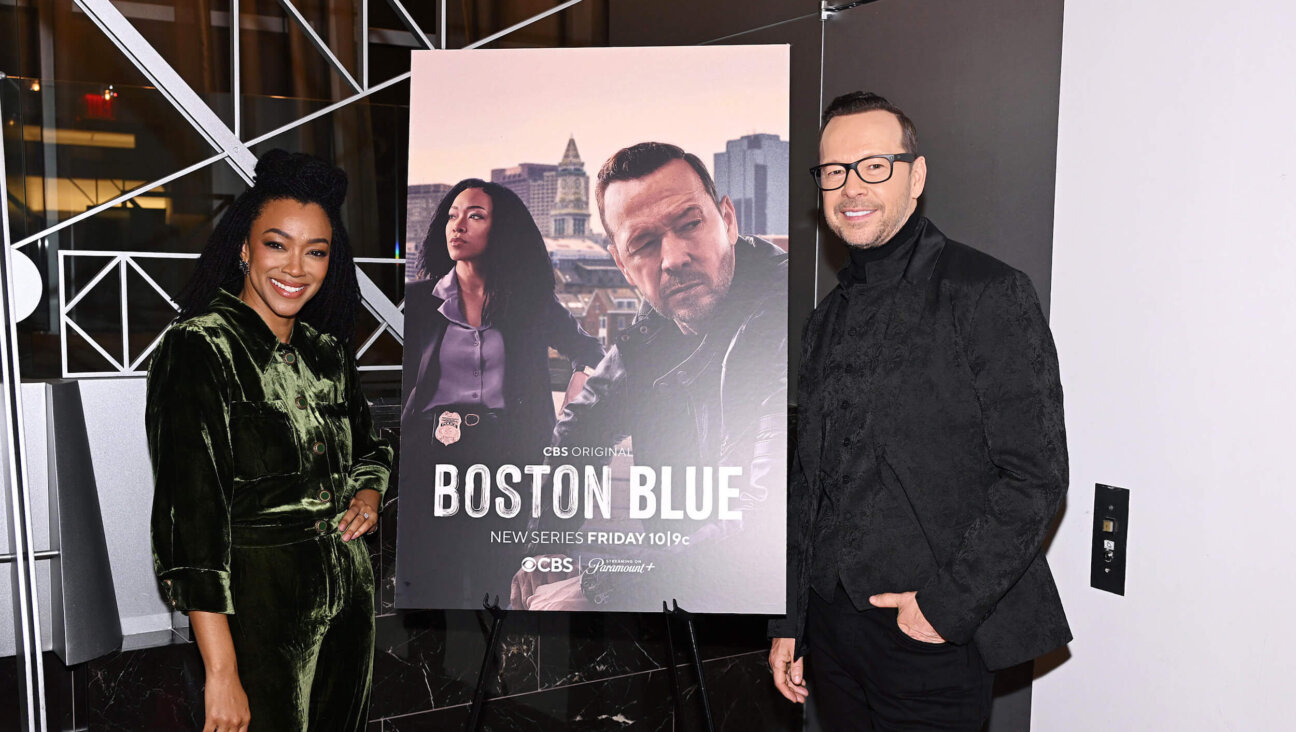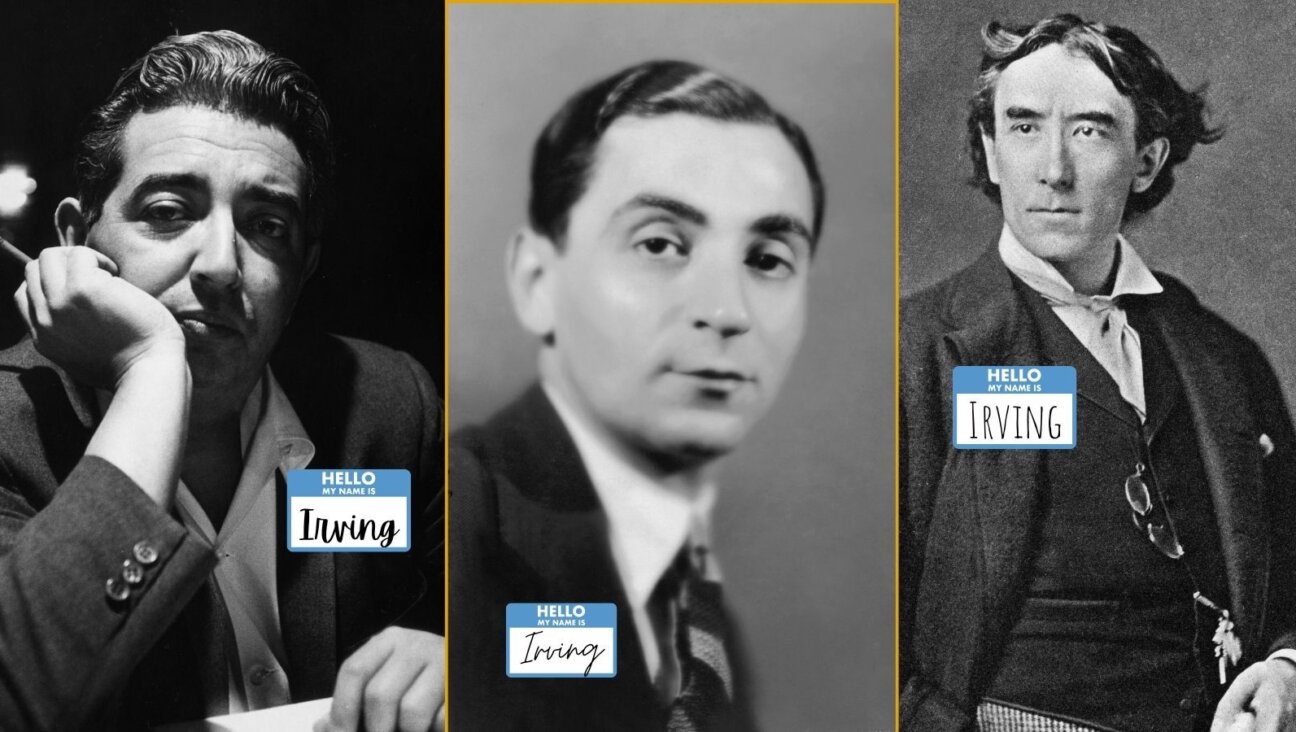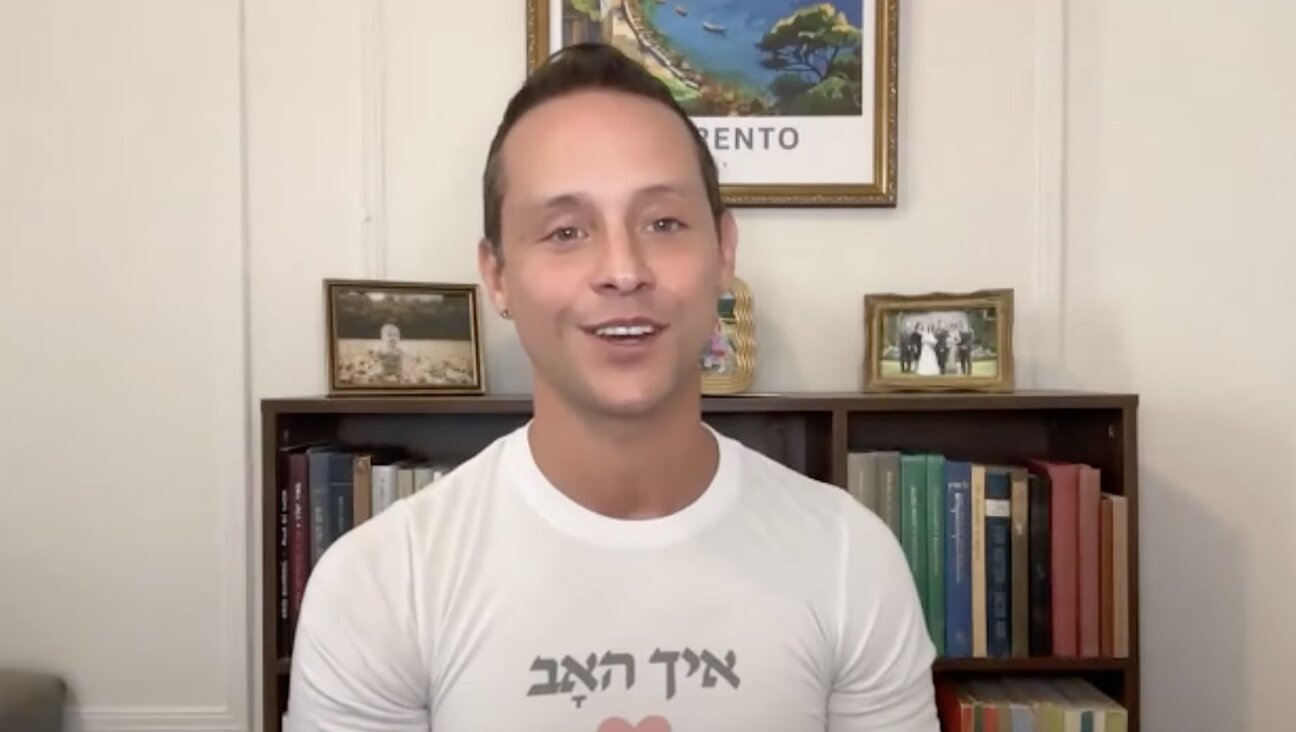Diving Into ‘The Melting Pot’ for Answers on Pew Survey of #Jewish America

The Author: Israel Zangwill, in 1913, the man who coined ?The Melting Pot? as a phrase and idea, Image by Getty Images
When the researchers at Pew released their study in early October, they offered a series of statistics that were supposed to offer “A Portrait of Jewish Americans.” While I admit I’m not a quantitative type, its seems that a third of Jewish America immediately despaired the fate of Jews; then a third of Jewish America despaired the poll; meanwhile, a third didn’t know or care about it.
Of course, we only hear about the noisy two-thirds: those who despaired one way or the other and entered the debate publicly (see the Forward exchange between J. J. Goldberg and Alan Cooperman and Greg Smith, and Goldberg again, not to mention articles in Tablet, The New York Times, Telegraph, Huffington Post, and the Forward’s collection, Who Are We Now, the fastest ebook ever produced), or privately, slinging accusations on Facebook walls.
The initial response to the Pew’s results — the end of Judaism is nigh! — calls to the mind of a literary critic the initial reception of the 1908 play, “The Melting-Pot,” which made the British writer Israel Zangwill a hero to some and a traitor to others (or better yet, trader — of his role of Jewish leader for a mess of melted pottage). It’s from “The Melting-Pot” that we get the very term that’s come to define America. But “The Melting-Pot” is not, as you might think, about a bunch of people from all different countries who come together and magically there’s e pluribus unum. It’s about Jews. And the message — for those who worried about the preservation of the Jewish people and their ways — was thought to be “a grim portrait of the American Jewish population,” to cite Jack Wertheimer’s response to the Pew a century later.
In the play, the possibility of America as a “melting pot” comes to life with the love affair between Jewish David, whose family was killed in a Russian pogrom, and Vera, whose father orchestrated the pogrom. If these two can make it, then America really is a place where all the “blood hatreds and rivalries” of the Old World can be melted, and the superman, as David calls the fusion of the races, can rise.
No matter that the much-discussed marriage of the star-crossed lovers never takes place in the play; that the American is ever a future ideal (“I should have thought the American was made already — eighty millions of them,” says David’s uncle. But David responds, “No, uncle, the real American has not yet arrived”); that this play was probably Zangwill’s way of pissing off the Zionists with whom he broke after divergent reactions to the 1903 Kishinev massacre that the play uses as its backdrop (Z., a major figure in Herzl’s Zionist movement, was all for the Uganda Plan. The bulk of Zionists were not. So Z. went all “My Country ‘Tis of Thee”/We’ll have a new Promised Land in America on them). Viewers took David’s idealism about assimilation (no matter that his last name was Quixano — the same as that other fictional idealist whose battles with windmills have been the source of humor for centuries) in earnest, and understood the play to be a happy pronouncement of the end of Judaism.
Teddy Roosevelt was invited to the play’s Washington opening in 1909, and his enthusiasm for it is legendary. He reportedly shouted, “It is a great play, Zangwill!” Roosevelt wrote some years later, “That particular play I shall always count among the very strong and real influences upon my thought and my life.” The influence is clear in his 1915 “There is no room in this country for the hyphenated American” speech.
Henry Ford, who hated Jews (and must have loved what he saw as the end of the Jews) thought the idea so brilliant he brought the crucible to life for his workers, staging a pageant for his Americanization School’s graduation ceremony, complete with immigrant factory workers dressed in Old World costumes descending into a 20-foot-tall cauldron only to re-emerge as flag-waving Americans in business suits (and if you haven’t read Jeffrey Eugenides’s fictionalized version of it in Middlesex, run your fingers — don’t walk them — straight to amazon.com and order the book!).
On the other hand, there was a second reaction to the play — those who refused to take seriously a British playwright’s fantasy of an imminently Judenfrei America. Philosopher and German-Jewish immigrant Horace Kallen thought that any assimilation of the Jew was temporary in nature and economic in reason, and “Once the wolf is driven from the door and the Jewish immigrant takes his place in our society a free man and an American, he tends to become all the more a Jew.” Similarly, Randolph Bourne, who envisioned America as an “international nation,” a salve to the world war happening across the Atlantic, argued the melting pot was a myth (and a poor ideal, and a symbol of the past, and a failure. He wasn’t keen on it). He said, instead, that as immigrants “became more and more firmly established and more and more prosperous, [they began] to cultivate more and more assiduously the literatures and cultural traditions of their homelands” (Nathan Glazer and Daniel Patrick Moynihan, four-term New York senator, echoed precisely this sentiment 60 years later, saying minority groups “become more ‘American’ and less ethnic all the time”; however, “in the course of participating in this process, they may also — simultaneously — become more ‘ethnic’”).
Many early 20th-century Jews were compelled by the well-argued writings of Kallen and Bourne and not melting pot rhetoric. They might have also been compelled by continuous signs that Jewishness was everpresent in America. Want to know the first two songs with words Americans ever heard in film? A ragtime piece and Kol Nidre. Jews were staying Jews. And a century later, even if some numbers are declining, it’s looking like Kallen knew a lot more than, say, Henry Ford (though maybe not about cars).
Now ironically, with a whole century of hindsight (something that we could probably use before we take too seriously the Pew results), we can see that pro or against the ideology that was being attributed to Zangwill, no one a hundred years ago really understood his play (or maybe they just never saw or read it. “The Melting-Pot” is probably just one book below Joyce’s Ulysses as the most influential never-read book).
“Not our race,” says David’s uncle, “not your race and mine.” He says this when David calls for everyone to go into the crucible, where the past gets burned off in the roaring and bubbling seething of the fires (sounds very inviting). David’s uncle, we should note, is the voice of reason throughout the play. Unlike David’s grandmother, the traditional symbol of the Old World, a figure who would show up again as the father in Anzia Yezierska’s “The Bread Givers” and the cantor-father in “The Jazz Singer” and the rabbi in “Call it Sleep,” David’s uncle is a nice embodiment of integration. Like their house boasting the stars-and-stripes and a mizrach, he is the figure of Jewishness and Americanism. If Teddy Roosevelt lauded the play because it fit with his belief that “there are no hyphenated Americans,” he missed the significance of Uncle Mendel.
And indeed, “our race” never really falls into the Crucible in the play. If we re-examine the “data,” we can find the abandonment of Judaism is not the de facto message of “The Melting-Pot.” Instead, when Vera decides to marry David, she says to him, “David, I come to you, and I say in the words of Ruth, thy people shall be my people and thy God my God!” If this isn’t a conversion tale, I don’t know what it is. Forget Jews losing their faith; Christians are becoming Jews! (And Vera’s not the only one. The Quixano maid, who spends the first scene complaining about all the restrictions of kashrut and Shabbat, is asked why she’s celebrating Purim at the end of the play, and she replies, “Bekaz we’re Hebrews!” Of course, the Irish maid is always a great source for humor, but–).
On the other hand, if the play is not about all of gentile America turning Jewish (we can consider this interpretation), if it really is about a potential loss of Judaism, Zangwill isn’t really throwing out the tallis with the tefillin. When David does finally agree to marry Vera, the “happy ending” is written with the greatest reservation a romantic tale could have (Jane Eyre’s getting Rochester at the expense of a hand, an eye, and vision in his remaining eye possibly excepted). He says, “Kiss me, kiss me now… .It will make me forget. Kiss me.” It sounds a bit like “Shoot me already. Shoot me and get it over with.” And then there’s this: “Stage directions: [There is a pause of hesitation, filled up by the Cathedral music from ‘Faust’ surging up softly from below].” He gives into the marriage and sells his Yiddishe soul to the devil in so doing. Ambivalent much, Zangwill?
To conclude, we might say there are at least three interpretations of the impending marriage, most of them fairly positive:
-
The Rainbow reading: That the marriage will take place, and they’ll create a brood of Russian-Christian-Jewish-noble-but-poor American babies who will bridge cultural and religious and class divides, so this is a good thing. Even if you’re completely opposed to intermarriage, you can’t possibly be opposed to cultural harmony (can you?).
-
The Rooseveltian/Nietzschean/Sci Fi reading: That the marriage will take place, and David’s Jewishness will burn up in the crucible, and this is a good thing, even if you think it’s not, because although there will be no more Jews, the crucible will spew out a whole race of supermen.
-
The Goethean reading: That the marriage will take place at the cost of David selling his soul to the devil either because this is a cautionary tale against intermarriage or because Vera converts and drives him crazy. Cautionary tales are instructive, so we’ll call this a good thing.
I suppose there’s also The Marriage Plot reading — that the (possibly dangerous/possibly promising) marriage never takes place, and a bunch of Jews were arguing about the fate of their culture and religion for no particular reason. But that would be crazy, right? It’s far more interesting to worry about the very grim portrait of the health of the American Jewish population than think about Jews as a thriving, successful ethnic group in America.
But maybe it’s that last third that has it right. Right now, they’re sitting back, nibbling on some knaidelach, watching “The Goldbergs” and realizing that poll or no poll, Jews are fine.
Karen E. H. Skinazi is a lecturer at Princeton University, where she teaches a seminar called “America and the Melting Pot.”















